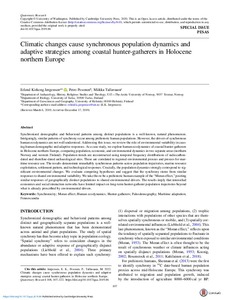Climatic changes cause synchronous population dynamics and adaptive strategies among coastal hunter-gatherers in Holocene northern Europe
Jorgensen Erlend Kirkeng; Pesonen Petro; Tallavaara Miikka
Climatic changes cause synchronous population dynamics and adaptive strategies among coastal hunter-gatherers in Holocene northern Europe
Jorgensen Erlend Kirkeng
Pesonen Petro
Tallavaara Miikka
CAMBRIDGE UNIV PRESS
Julkaisun pysyvä osoite on:
https://urn.fi/URN:NBN:fi-fe2022102463100
https://urn.fi/URN:NBN:fi-fe2022102463100
Tiivistelmä
Synchronized demographic and behavioral patterns among distinct populations is a well-known, natural phenomenon. Intriguingly, similar patterns of synchrony occur among prehistoric human populations. However, the drivers of synchronous human ecodynamics are not well understood. Addressing this issue, we review the role of environmental variability in causing human demographic and adaptive responses. As a case study, we explore human ecodynamics of coastal hunter-gatherers in Holocene northern Europe, comparing population, economic, and environmental dynamics in two separate areas (northern Norway and western Finland). Population trends are reconstructed using temporal frequency distributions of radiocarbon-dated and shoreline-dated archaeological sites. These are correlated to regional environmental proxies and proxies for maritime resource use. The results demonstrate remarkably synchronous patterns across population trajectories, marine resource exploitation, settlement pattern, and technological responses. Crucially, the population dynamics strongly correspond to significant environmental changes. We evaluate competing hypotheses and suggest that the synchrony stems from similar responses to shared environmental variability. We take this to be a prehistoric human example of the "Moran effect," positing similar responses of geographically distinct populations to shared environmental drivers. The results imply that intensified economies and social interaction networks have limited impact on long-term hunter-gatherer population trajectories beyond what is already proscribed by environmental drivers.
Kokoelmat
- Rinnakkaistallenteet [27094]
